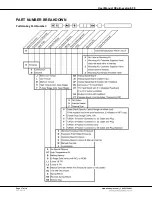
User Manual RCx-B-xxxAx-8.09
Page 6 of 18
www.hanbayinc.com | 1 800 315 4461
Rev.2021.8 [email protected]
Operation
DIP switches
The DIP switches allow you to change the
settings on your actuator. To flip a switch,
gently use a small flat-head screwdriver.
See the table below for DIP switch functionality.
DIP
Function
1
2
Speed:
Choose how quickly the actuator will turn the valve. See p.8.
3
Only in the ON position for actuator model RCH (with external gear stage).
4
5
6
7
8
Turns:
The actuator usually ships from the factory with the recommended number of turns for the
valve. However, this number can be changed. Turning on a switch will add a specific number of
turns to the actuator’s movement.
See p.8 for relation between positions of the DIP switches and number of turns.
Example: Turning on DIP 6 adds four turns, turning on DIP 8 adds one turn. If both DIP 6 and 8 are
on, then the total turns of the actuator would be five.
9
Signal loss:
See p.10.
10
11
Seating Torque:
Set how much torque the actuator exerts on the valve lever during the calibration
(finding valve seat) procedure. See p.8.
12
Direction/Calibration:
Toggle switch on and off while powered to re-calibrate actuator (find valve
seat). Also sets direction in which the actuator will open and close. See p.10.
Example: The RCM model actuator turns clockwise when the signal is decreased with DIP 12 in the
OFF position. Putting DIP 12 in the ON position will cause counterclockwise turning for a decrease
in signal. For changes in DIP 12 position to take effect, the power to the actuator must be cycled.
Controlling the Actuator
The 4-20 mA (or 1-5 V / 1-10 V) input signal represents a total span of a number of turns.
I.e.: If you set the number of turns to 2, then a signal of 12 mA will set the actuator to exactly 1 turn from the
fully closed position. 15 mA will give: (15-4)/16=0.6875
⇒
68.75% of 2 turns
⇒
1.375 turns from closed.
In this example DIPs 1, 2, 5 and 12 are on.


















